
Through the proposed Pell Grant Preservation and Expansion Act, Democrat lawmakers have proposed doubling the maximum award, among other changes to the program. And a substantial Pell increase of $550 for most students was part of the Build Back Better Act passed by the House of Representatives.
Because of how the Pell formula works, doubling the maximum Pell grant would not only increase the amount of grant aid for current recipients but would also expand eligibility to more students from middle-income households.
When interacted with other changes to the Pell program, substantial increases to the maximum grant amount would broaden the number of students who qualify for aid. Simplification changes already coming to the Pell program in the 2024 academic year (AY) will make some students eligible whose household incomes are currently too high to qualify.
Research on grant aid indicates that increasing and simplifying Pell would likely improve higher education access and student (PDF) outcomes, so these proposed changes could have a transformative impact for some college students.
Understanding a double Pell grant increase
I model the effect of doubling the maximum Pell amount under the current formula, which determines grant aid by taking the maximum Pell amount and subtracting a student’s expected family contribution (EFC). In practice, this adds the current maximum Pell amount ($6,495 for full-time students with a $0 EFC) to the Pell award of all full-time students currently receiving Pell. Thus, in their own aid packages, some current Pell recipients will experience a more-than-doubled Pell grant. For example, a full-time student with an EFC of $1,000 will go from a $5,495 Pell grant ($6,495-$1,000) to a $11,990 Pell grant ($12,990-$1,000), a 118 percent increase.
For full-time students with an EFC between roughly $6,000 and $12,000, doubling Pell provides a new Pell grant award, since eligibility is now doubled as well. Thus, doubling the maximum grant creates a substantial number of new Pell recipients who might have otherwise depended on other grant or student loan aid to fund their education.
When I factor in the upcoming 2024 changes to the Pell process, eligibility increases. Simplification will award a maximum Pell grant to those below 175 or 225 percent of the federal poverty threshold, and a minimum Pell grant to those household earning below 275, 325, 350, or 400 percent of the poverty level, depending on household structure. These new simplification rules will increase the award amount for some and give new eligibility to others.

Although policymakers could implement a doubled-Pell program that does not expand eligibility in line with the size of the grant, historically, Pell increases have followed this dollar-for-dollar model outlined above.
If policymakers wanted to increase Pell without expanding eligibility, they would likely have to reduce the size of the grant in a way that substantially reduces aid for students as their EFC increases. For example, if the formula reduced the grant size by $2 for every $1 gain in EFC, a student who sees an EFC increase of $1,000 might experience a Pell grant loss of $2,000.
Modeling the effects of doubling Pell on Pell receipt
How would doubling Pell change the share of students who receive at least some aid? To understand this, I model doubling Pell under current and future rules using data from the 2015–16 undergraduate National Postsecondary Student Aid Study. I look only at eligibility among students who applied for financial aid.
Some eligible students do not apply for financial aid (PDF) because they do not know about the process, fear taking on debt, or believe their family is ineligible. Simplifying the FAFSA will likely help increase applications and enrollment among low-income students.
Under current Pell grant rules, I estimate the share of students receiving a Pell grant increases most for dependent students from families in the third ($75,000–$125,000) and second ($38,000–$75,000) income quartiles. More than 90 percent of dependent students from the bottom half of family household income, and nearly all single independent students with children, are projected to receive a Pell grant.

When implementing the AY 2024 Pell rules, which would increase some dependent students’ need calculations but also impose minimum and maximum Pell eligiblity based on federal poverty thresholds, I find an additional jump in eligibility, especially among dependent students from the upper half of the household income distribution, mostly attributable to the minimum Pell rules. These students are more likely to receive relatively smaller grants (around $3,000).
If policymakers doubled maximum Pell under current formula rules, the share of undergraduate students who applied for federal financial aid and received any Pell aid would likely grow from 65 percent to 73 percent. When the AY 2024 changes come into effect, the share of students will increase further, to 79 percent. (These numbers are different than those in our Pell simulator, which provides data for all students enrolled during the year, whether or not they applied for aid.)
Doubling Pell would substantially expand access to college funding, providing a large increase in grant funding for current recipients and increasing the number of eligible students. If policymakers passed such a policy, it would likely improve student enrollment and persistence and reduce dependence on student loans.
The Urban Institute has the evidence to show what it will take to create a society where everyone has a fair shot at achieving their vision of success.
Let’s build a future where everyone, everywhere has the opportunity and power to thrive
Urban is more determined than ever to partner with changemakers to unlock opportunities that give people across the country a fair shot at reaching their fullest potential. Invest in Urban to power this type of work.